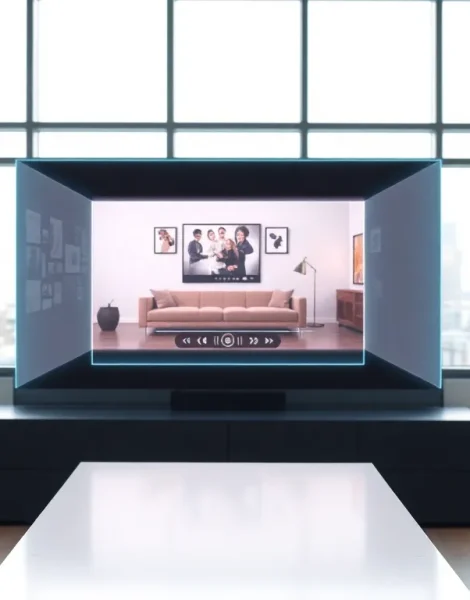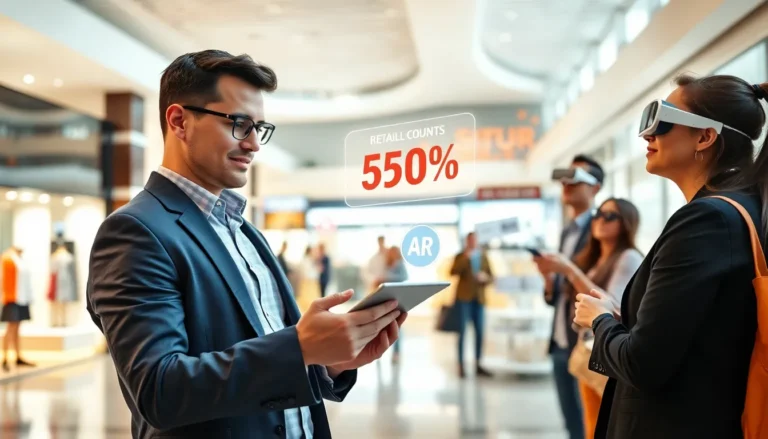Ever watched a video that made you feel like you could almost reach out and touch it? That’s the magic of augmented reality (AR) video. It’s not just a fancy gimmick: it’s a fascinating blend of the real and digital worlds that can leave you on the edge of your seat, or couch, as it were. Think about it: you’re viewing a video that superimposes digital elements onto your surroundings. The future is now, and it’s ready to change how we see the world, literally.
Table of Contents
ToggleWhat Is Augmented Reality Video?

Augmented reality video combines live-action footage with computer-generated images in real time. Instead of consuming content in a passive way, viewers engage in a dynamic interplay between the real world and interactive graphics. This technology enriches the video experience, enabling viewers to perceive objects layered in their actual environments, creating an immersive experience like no other.
Imagine watching a cooking tutorial where the recipe floats in holographic text above your ingredients, guiding you as you chop and sauté. Augmented reality video makes this kind of interaction possible, transforming typical viewing into an active and enriching experience.
As technology has advanced, AR has evolved from simple overlays to more complex and engaging formats. In the early days, it was mainly used for gaming and niche applications. Now, it’s finding its way into education, entertainment, retail, and beyond, providing endless possibilities and reshaping viewers’ interactions with their surroundings.
How Augmented Reality Video Works
At its core, augmented reality video works by harnessing a combination of hardware and software. The process begins with a device equipped with a camera, which captures live video. This is often paired with sensors and a GPS system, collecting data about the environment to provide context for the AR elements.
The magic occurs in real time. Advanced software processes the video feed to recognize surfaces, shapes, and objects. Once recognition happens, the program superimposes virtual items onto the video.
For instance, in an AR video showcasing furniture, the software will recognize the shape of a room and insert a virtual couch that fits perfectly in terms of scale and perspective. The viewer can then pan around their living space while the couch stays anchored to the selected spot, making it appear as though it genuinely belongs there.
The technology relies on augmented reality development kits (SDKs) which developers use to create unique experiences. Popular examples include ARKit for Apple devices and ARCore for Android. These platforms streamline the creation process, making it easier for developers to integrate AR elements into video applications.
Applications of Augmented Reality Video
Augmented reality video finds applications across various industries, each harnessing its immersive qualities to enhance engagement. Here are a few standout examples:
- Education: Schools use AR videos to create interactive lessons that resonate with students. Imagine exploring the solar system in your classroom while planets hover around you, giving new life to textbook knowledge.
- Retail: Brands are leveraging AR videos to enable customers to visualize products in their homes. With augmented reality, you can see how that stylish chair fits in your living room before making a purchase.
- Training: Companies employ AR video in employee training. Imagine a surgeon practicing intricate techniques with AR elements guiding their movements, bridging the gap between theoretical knowledge and practical experience.
- Marketing: Businesses showcase their products in an engaging format that grabs attention. An AR video advertisement might allow viewers to interact with products virtually, making the experience memorable and impactful.
- Gaming: AR gaming has taken the industry by storm. Games like Pokémon GO seamlessly blend the digital world with reality, where players can engage with virtual creatures in real-world settings.
Advantages of Using Augmented Reality in Video
The benefits of incorporating augmented reality into video are abundant and transformative:
- Enhanced Engagement: AR draws viewers into a mixed-reality experience, making content more engaging and interactive.
- Improved Understanding: By visualizing concepts in context, viewers can grasp complex ideas easily. This is particularly impactful in educational and training scenarios.
- Personalized Experiences: Consumers can tailor their experiences, turning static information into interactive journeys that resonate with their preferences.
- Increased Brand Loyalty: Brands that use AR effectively likely create lasting impressions, enhancing the customer journey and fostering loyalty through innovative experiences.
- Differentiation: In a crowded market, companies using AR to tell their brand story can stand out, offering unique content that captures attention.
Challenges and Limitations of Augmented Reality Video
Even though its many advantages, augmented reality video does face several challenges:
- Technical Barriers: The technology can be expensive to carry out and may require hardware updates or newer devices, which could alienate some potential users.
- Complex Development: Creating AR video content involves a steeper learning curve for developers. Mastering the tools and infrastructures necessary can take time and resources.
- User Adoption: Although AR is gaining traction, not everyone is comfortable with new technology. Users may need some convincing to adopt these innovative experiences.
- Content Overload: In some cases, too much information can overwhelm users. Balancing realism with user experience is critical to ensure engagement without confusion.
- Privacy Concerns: With the integration of camera technology in AR applications, concerns about privacy and data security arise, necessitating careful navigation.
The Future of Augmented Reality Video
The future of augmented reality video looks promising, with significant advancements on the horizon. As technology continues to evolve, we can expect more streamlined AR development processes and increasingly immersive experiences.
Artificial intelligence will play a pivotal role, enabling machines to better understand environments and automate the creation of personalized AR experiences. Besides, advancements in hardware, such as lightweight AR glasses, could revolutionize how users interact with the digital layer overlaid on reality.
As more sectors adopt AR for education, marketing, and entertainment, the technology will likely become a household norm. Consumer familiarity will rise, leading to broader acceptance. Imagine a world where each video you watch offers an interactive dimension, enhancing education, enriching leisure, and transforming industries.









